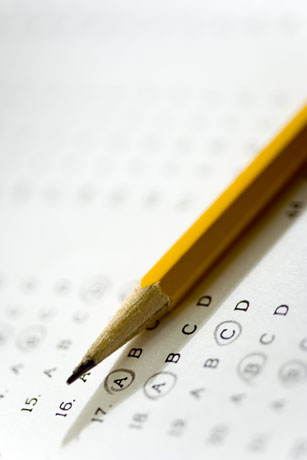 My son gets mostly A’s and B’s on his homework, but he does poorly on his exams. When test time comes, he gets nervous. He draws a blank. He simply can’t remember what he studied the night before. He has classic symptoms of test anxiety. Fortunately for kids like my son — and there are many — knowing what strategies to employ can make all the difference.
My son gets mostly A’s and B’s on his homework, but he does poorly on his exams. When test time comes, he gets nervous. He draws a blank. He simply can’t remember what he studied the night before. He has classic symptoms of test anxiety. Fortunately for kids like my son — and there are many — knowing what strategies to employ can make all the difference.
It’s a testing world
Kids today take a lot of tests. In fact, in today’s schools, standardized testing consumes almost 20–50 hours per year. Plus, students can spend 60–110 hours per year in test preparation alone. This increased emphasis on testing starts as early as the third grade, which invariably creates more pressure on students to excel. Because of this, we are seeing more students with test anxiety; in fact, test stress affects more than 20 percent of all students, making it the most prevalent impairment in school today. Clearly it is no small problem, and left unchecked, test anxiety can have an impact on long-term learning.
What is test anxiety?
Test anxiety can manifest itself in a variety of ways. Depending on how old the student is, parents and educators can see a wide range of emotions, from absolute refusal to go to school to stomachaches to loss of sleep to heart palpitations to a real sense of dread and failure. Sometimes, says University of Chicago psychology professor and researcher Sian Beilock, students see failure at test taking as an indictment of who they are as a person, so they don’t feel like they have the ability to succeed. In her research, Beilock has seen kids as young as 6 years old with test anxiety. What really happens, says Beilock, is that these worries can have an impact a person’s ability to hold information in their head via their working memory. “The key is to figure out how to help kids manage this anxiety,” she says.
Test anxiety’s impact on the working memory
Working memory is our short-term memory cache, which temporarily stores information until we decide to permanently remember it. Consisting of a central executive function that controls and coordinates our auditory and visual spatial abilities, working memory is, says Beilock, our cognitive horsepower. Working memory is “like a mental scratchpad that helps us keep what we need in mind and other things out. It helps us remember all sorts of things in our daily life, like our phone number or doing math problems.” But working memory is limited, Beilock says, when we are stressed and anxious, and these worries can co-opt the working memory so we have less brainpower to use.
Some kids have strong working memories, and others do not. For instance, with a math word problem, kids must keep the numbers in their memory, figure out how to solve the problem and then write out the solution on their worksheet. Kids with poor working memories might have trouble capturing and keeping those numbers in their head. But for kids with test anxiety, their worries about failure and forgetting essentially elbow out what they studied the night before. As a result, their worries take over their memory. As with my son, anxious test-takers may draw a blank or simply not be able to grasp exactly what the test is asking of them.
So for students who have test anxiety, the question is how can we free them from stress and anxiety when they are taking a test so they can fully use their working memory?
 Deep muscle relaxation and breathing
Deep muscle relaxation and breathing
One successful method is deep muscle relaxation and breathing. Psychologist Heidi Larson, assistant professor at Eastern Illinois University, has conducted studies with students ranging from third-graders up to high school students on the impact of deep muscle relaxation and breathing on test anxiety. She has found that teaching students to do these exercises has significantly helped to reduce their anxiety. When she added chewing gum to the mix, she found that it also increased students’ focus on their performance in other areas in addition to test taking. The whole idea, Larson says, is to slow down your system, breathing through the stress so you are able to recall and remember what you learned. She believes that everyone needs to learn to manage their stress, and that teaching students how to relax their muscles and do deep breathing is a life skill.
Expressive writing
Another method of reducing test anxiety was pioneered by Beilock. Patterning her research after that done with patients with depression, she found that students who engage in expressive writing can reduce their test anxiety and improve their test grades by nearly a grade point. There is a long line of research in clinical psychology showing that for depressive individuals who tend to have more physical ailments, writing and journaling can be a great way to reduce doctors’ visits and physical consequences,” Beilock says.
In the case of test anxiety, students use expressive writing to share their fears and anxieties. By leaving their worries and stress on the page, they effectively eliminated their worries and were able to free up their working memory to remember what they studied. Still, one size doesn’t fit all, Beilock says. Every kid is different.
Larson agrees. “Each of us releases tension in different ways. I think that putting it all down on paper can have the same effect [as deep muscle relaxation and breathing]. But what I like about muscle relaxation and deep breathing is that it is a quick and simple tool that we know is effective,” she says.
For educators and parents, information about these two methods just might relieve some stress of their own. And while some anxiety is useful, because it can help a student prepare and study, too much anxiety is harmful, Larson says. Learning to employ these methods could improve scores now and help a student later on when they have even bigger issues to tackle.











